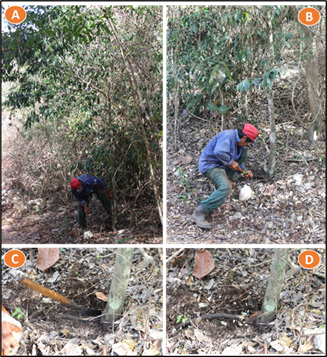Mini Review 
 Creative Commons, CC-BY
Creative Commons, CC-BY
Malmea Depressa, The Plant of The Future for The Treatment of Diabetes Type II and Kidney Stones
*Corresponding author: Domínguez May AV, TecNM-Higher Technological Institute of the South of the State of Yucatan, Mexico.
Received: February 25, 2025; Published: March 03, 2025
DOI: 10.34297/AJBSR.2025.26.003399
Abstract
Malmea depressa is distributed in Mexico, Central America to Honduras; it is used for the treatment of hyperglycemia and urinary lithiasis, scientific studies have shown that the infusion of roots of this tree, that is consumed in some communities of Yucatan, effectively is functional.
Keywords: Deep learning, Transformers, Drug Discovery, Machine Learning, Multi-omics, Machine Learning, Bioinformatics
-->Geographical Distribution
Malmea depressa is a tree that belongs to the Annonaceae family. In our country, this plant species is distributed in the states of Guerrero, Jalisco, Michoacán, Oaxaca, Tabasco, Campeche, Chiapas, Quintana Roo, Veracruz and Yucatán; but it has also been located from Central America to Honduras [1].
Common Names
This plant, in the Mayan language, is known by different names, ek-ele-muy, elemuy-box, eklemoy or elemuy [1].
Botanical Synonymy
Elemuy can have different scientific names, such as Guatteria gaumeri, Mosannona depressa and Malmea depressa [1,2].
Traditional use
This tree has been used since pre-hispanic times; Its bark and root have been used for the treatment of kidney conditions and hypercholesterolemia [2] and it is traditionally used in Mayan communities for the treatment of diabetes type II [3]. In Yucatan, Malmea depressa is also used for the treatment of renal lithiasis or kidney stone [4].
In particular, in the community of Xohuayan, Oxkutzcab, Yucatan, the infusion of Malmea depressa roots (Figure 1) is consumed as a natural remedy for the treatment of kidney stones and pounce. According to the opinion and experience of the people of this community, they report that this plant is very effective for the treatment of urinary lithiasis or kidney stones. The infusion of the root also helps the elimination of water through the urine; therefore, they consider it as a diuretic (Figure 1).

Figure 1: Malmea depressa tree, known as elemuy in the Mayan language.
A) Mr. Eleazar Domínguez Tun, member of the community of Xohuayan, carrying out cleaning activity around the tree,
B) Mr. Eleazar digging near the roots of the elemuy.
C) Coa, a tool used to dig and weed weeds.
D) Root separated from the stem of Malmea.
Studies in the Laboratory
The aqueous, ethanolic and butanoic extract of roots of Malmea depressa lowers the blood glucose levels in diabetic rats. In the case of root infusion, as it is commonly prepared in communities, it was shown to be effective [5]. In addition, butanoic extract has been shown to stimulate insulin release [6] and block hepatic glucose production [3].
Chemical Composition of the Root Extract
Through HPLC analysis, it was determined that the roots contain phenyl butane derivatives, 2-Hydroxy-3,4,5-trimethoxy-1- (2’,4’-Hydroxy-3’-dihydroxy) butyl-benzene, and 2-hydroxy-3,4,5- trimethoxy-1-(2’,3’,4’-hydroxy) butyl-benzene. Laboratory studies, demonstrated that these compounds are relationates with pharmacological activity of the extract against diabetes type II [5].
Conclusion
Malmea depressa or elemuy is an alternative for the treatment of diabetes type II and kidney stones, it has been demonstrated by Scientifics. We believe that it would be important to deepen the phytochemical studies of the natural remedies prepared by Maya communities, to rule out side effects.
Acknowledgements
None.
Conflicts of Interest
None.
References
- (2010) Herbarium of the Scientific Research Center of Yucatan, Natural Resources Unit. Mosannona depressa [Internet]. Yucatán, Mexico:Flora Digital, Yucatan Peninsula.
- Mejía R (2016) Guatteria gaumeri, Malmea depressa or Yumel, a review of its history, its properties and its use in homeopathy. The Homeopathy of Mexico 85(700): 28-38.
- Andrade Cetto A (2011) Inhibition of Gluconeogenesis by Malmea depressa root. J Ethnopharmacol 137(1): 930-933.
- Villalobos Perera PA, Martínez Natarén D, Munguía Rosas MA, Castillo Burguete MT (2023) Plants used to treat renal lithiasis, or kidney stones, in the central region of the state of Yucatán, Mexico. CICY:7-11
- Andrade Cetto A, Matínez Zurita E, Wiedenfeld H (2005) Hypoglucemic effect of Malmea depressa root on streptozotocin diabetic rats. Journal of Ethnopharmacology :1-4.
- Andrade Cetto A, Matínez Zurita E, Soto Constantino A, Revilla Monsalve C, Wiedenfeld H (2008) Chronic hypoglycemic effect of Malmea depressa root on n5-streptozotocin diabetic rats. Journal of Ethnopharmacology 116: 358-362.



 We use cookies to ensure you get the best experience on our website.
We use cookies to ensure you get the best experience on our website.